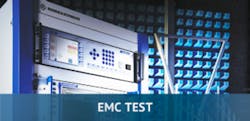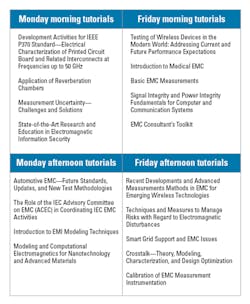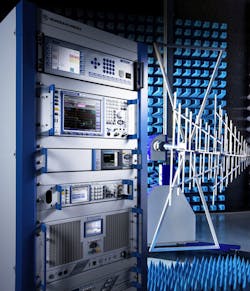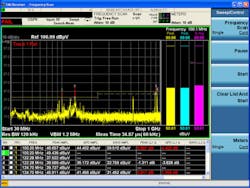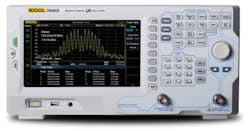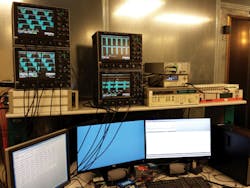EMC Test: Instruments, software span validation to compliance
Electromagnetic compatibility has long been a key consideration of successful product design. As speeds increase, concerns related to signal and power integrity also come to the fore. Such topics will be at the forefront at the 2016 IEEE International Symposium on Electromagnetic Compatibility (EMC 2016), which will include exhibits as well as technical presentations when it convenes July 25-29 in Ottawa.
The symposium will begin with full-day tutorials on “Fundamentals of EMC” and “Military EMC.” Half-day tutorials will cover a variety of topics, including the IEEE P370 Standard (“Electrical Characterization of Printed Circuit Board and Related Interconnects at Frequencies up to 50 GHz”), reverberation chambers, measurement uncertainty, electromagnetic information security, automotive and medical EMC, EMI modeling techniques, computational electromagnetics for nanotechnology and advanced materials, wireless device test, signal integrity and power integrity fundamentals for computer and communication systems, managing risks with regard to electromagnetic disturbances, smart-grid EMC issues, crosstalk, and calibration (Table 1).
Testing services
Several test-and-measurement companies have shared their plans for the symposium. D.L.S. Electronic Systems offers a variety of EMC testing and consulting services to the electronics, medical equipment, automotive, aerospace, computer, telecommunications, and other industries. President Donald L. Sweeney said the company will be promoting its compliance programs for RTCA-DO-160, MIL-STD-461, and the European EMC, LVD, and RED directives at EMC 2016. The company provides links to the latest EMC rules and regulations, which EE-Evaluation Engineering readers can access at www.dlsemc.com/EE-July2016.
“We offer ‘up-front’ engineering reviews and assessments that address noncomplaint design issues prior to testing, which saves both time and money,” Sweeney said. “Later when the client comes back for testing, our engineers are knowledgeable in the correct way to perform the tests, and they are highly skilled at solving any issues that are revealed during the testing.”
Sweeney added, “Besides our knowledgeable test engineers, D.L.S. has invested in state-of-the-art test equipment that supports the most current global wireless and radio standards to ensure the most accurate test results in the most expedient amount of time.”
From R&D to compliance
Rohde & Schwarz offers EMI/EMS measurement solutions (Figure 1) for the entire development cycle—including design verification, precompliance, and full compliance. At EMC 2016, said Faride Akretch, marketing manager, “We will showcase solutions used in the development and design verification phase, such as oscilloscopes and spectrum analyzers for EMI debug, to solutions for precompliance and full compliance, such as EMI receiver, amplifier, and test systems.” The company’s offerings also include amplifiers, antennae, chambers, and automatic test systems—for example, for visual inspection as it relates to EMC.
Courtesy of Rohde & Schwarz
Akretch highlighted two new products in particular that will appear at the show. “The ESW EMI test receiver offers outstanding RF characteristics, including high dynamic range and measurement accuracy and meets the most stringent requirements for certification measurements in line with CISPR, EN, MIL‑STD-461, DO‑160, and FCC,” he said. “With its FFT-based time-domain scan, the R&S ESW captures and weights disturbance spectra in virtually no time. The instrument’s real-time spectrum-analysis capability with 80-MHz bandwidth and spectrogram function permits a detailed analysis of disturbance signals and their history.”
Akretch also cited the R&S BBA150 and BBL200 broadband amplifier families. The compact BBA150 generates power in the 9-kHz to 6-GHz frequency range and is suitable for amplitude, frequency, phase, and pulse modulation. Extensive switching options for input, output, and sample ports are available. The R&S BBL200 amplifiers serve applications requiring high RF power. They generate up to 10 kW of power in a 9-kHz to 225-MHz frequency range. They are liquid-cooled, solid-state, rugged, quiet, and efficient. Precise monitoring of all runtime parameters ensures maximum robustness and reliability.
He elaborated on the company’s EMI receivers. “We help our customers by offering test results that are beyond a simple pass or fail,” he said. “The increasing percentage of EMI compliance failures necessitates an improved capability not only in detecting emissions, but also in characterizing the failing emissions. Combining the traditional spectrum plot with the real-time-mode spectrogram and persistence displays provides the user with a variety of tools that can be used to identify the root-cause of failed EMC tests.”
Akretch cited several key features and capabilities:
- Time-domain scan provides real-time spectrum feedback thousands of times faster than traditional spectrum analyzer measurements.
- Real-time-mode spectrogram displays show a color-coded representation of signal strength over time. “This is extremely useful when examining the time nature of signals and when measuring pulse repetition rates without resorting to the zero span mode in a swept spectrum analyzer,” he said.
- Real-time-mode persistence displays amplitude as a function of the percentage of time the signal was at that amplitude. “This gives the EMC designer the ability to visualize time-multiplexed signals, or ‘signals under signals,’ eliminating costly multiple rounds of full EMC testing,” he explained.
Rohde & Schwarz also will offer a presentation titled “Capturing Pulsed/Intermittent Signals” as part of the “Hardware Experiments and Demonstrations” portion of the symposium. Attendees will learn how the growing complexity of electronics within both military and commercial products is resulting in the emission of more pulsed/intermittent signals, which although difficult to detect must be properly characterized during EMC testing.
Presenters will note there are several methods to perform the task of measuring the electromagnetic (conducted or radiated) emissions of a pulsed signal and will describe three EMC test methodologies: frequency-swept, frequency-stepped, and time-domain-scan.
Instruments and software
Mark Terrien, EMC business manager at Keysight Technologies, said, “We will be highlighting our electromagnetic simulation software, our EMI precompliance test, and our EMI-compliant receiver. These products cover the entire breadth of activities in the electromagnetic environment that face product designers and compliance test houses. With our partners, we offer customers complete precompliance and compliance measurement solutions.”
Terrien said Keysight will present the following demos at the EMC Symposium:
- standards-compliant EMI measurements with signal-analyzer-based diagnostics to 44 GHz and higher with the recently added external mixer support for millimeter-wave using the N9038A MXE EMI receiver;
- precompliance measurement and diagnostic evaluation tools with the N6141A EMI measurement application (Figure 2) on X-Series signal analyzers;
- EMPro 3D EM software to simulate emissions levels vs. frequency and compare to common FCC, CISPR, and other EMI emissions standards;
- PLTS that supports the flexible PXIe chassis form factor with VNA modules for multichannel analysis of high-speed digital interconnect; and
- PDN component characterization with the ENA network analyzer with the impedance measurement function.
Courtesy of Keysight Technologies
“Our products provide detailed design, troubleshooting, and compliance information across the breadth of EMC applications,” Terrien said. “Our EMPro 3D EM simulation software enables designers to simulate the EMC performance of their products early in the design stage. Working with our Advanced Design System software package, this powerful software solution can help customers complete their designs rapidly and avoid signal integrity and electromagnetic compliance issues.”
In addition, he said, “The N6141A EMI measurement application transforms X-Series signal analyzers into an EMI precompliance and diagnostic solution, providing data collection and analysis tools to facilitate rapid time-to-market for new designs.”
Finally, he noted that the N9038A MXE EMI receiver provides compliance measurement and diagnostic capabilities for all commercial and military applications. “With the new real-time spectrum analysis capability for diagnosing high-speed signals and new millimeter-wave frequency coverage, the N9038A is a comprehensive compliance measurement tool,” he said. “Our MXE EMI receiver recently introduced millimeter-wave measurement capability. With a range of external millimeter-wave downconverters, the receiver can cover to the 231-GHz FCC upper frequency range and beyond.”
Keysight also will present a paper titled “Millimeter-wave Emissions Measurement Challenges for FCC Intentional Radiator Compliance.” The paper will provide an overview of millimeter-wave EMC measurements for FCC intentional radiator measurement applications and discuss issues associated with the creation of these measurements. The presenter will note that millimeter-wave EMC measurements will become more important as solutions for 60-GHz WiGIG and millimeter-wave broadband Internet of Things applications are introduced over the next five years.
Precompliance solutions
Jason Chonko, applications engineer at Rigol Technologies USA, said his company will be highlighting several EMC precompliance solutions at the show. “At Rigol, our goal is to provide engineers and technicians with the tools that help them solve technical challenges in a cost-effective manner,” he said. “Each of these new products represents our next steps toward achieving that goal.”
The products include the NFP-3 near-field probe kit that provides engineers and technicians with simple tools for investigating EMI emissions from boards and enclosures. These near-field probes are designed to work seamlessly with Rigol DSA spectrum analyzers.
“These sniffer probes are used to identify sources of EMI on boards as well as ‘leaks’ in enclosures and cut-outs,” Chonko said. “These handheld electrically insulated probes offer a convenient way to measure magnetic and electric fields produced by EMI. This can help designers isolate causes of EMI earlier in the design phase and correct for issues before they undergo fully compliant testing, where changes can be expensive and delay product release.”
The company also will feature the DSA800 Series of spectrum analyzers (Figure 3), which now includes analyzers that cover 1.5-, 3.2-, and 7.5-GHz maximum frequency ranges. These swept superheterodyne analyzers deliver accurate amplitude vs. frequency information with a low DANL and a flexible digital platform.
Courtesy of Rigol Technologies
The analyzers, Chonko said, provide amplitude vs. frequency information in a small and cost-effective package. “Our DSA800 series of spectrum analyzers features low noise, wide operating frequency ranges, tracking generator/preamplifier options, an EMI toolkit with a QuasiPeak detector, as well as on-screen limit lines and correction tables,” he added. “These features make precompliance testing easier than ever.”
Also on display will be the new EMI Test System software, which works with the Rigol DSA Series of spectrum analyzers to create and execute precompliance scans, including limit line creation and correction tables. It also features a report-generation tool.
“The EMI Test System software coupled with a Rigol DSA spectrum analyzer provides a ‘one-stop’ solution for collecting precompliance data,” Chonko said. “It serves to control the spectrum analyzer setup, scan sequencing, data collection, and reporting.”
And finally, the company will present the new DSG800 Series RF sources, which provide capabilities for precompliance susceptibility and broadcast testing of receivers and RF components.
Oscilloscopes for ESD/EMC
Mike Hertz, field applications engineer, Teledyne LeCroy, said the company will focus on using oscilloscopes (Figure 4) for ESD/EMC testing. “Teledyne LeCroy offers a unique solution for the ESD RC time-constant measurement, accurate automatic threshold placement for ESD pulse rise-time measurements, decay time, level-at-pulse, radiated immunity testing with parameter limit testing, and many other EMC-specific measurements,” he said.
Courtesy of Teledyne LeCroy
A Teledyne LeCroy application note1 describes immunity testing using an EMC chamber and an array of oscilloscopes. “Although oscilloscopes are well equipped to perform the rapid parametric measurements required for determining EMC deviation in immunity testing, they often have been overlooked in the past mainly due to lack of awareness and lack of sufficient oscilloscope channel count,” the note states. “Using an array of oscilloscopes is potentially the most efficient and cost-effective method to qualify component sensor outputs during immunity test, since most of the functionality using pass/fail mask and parameter limit testing has already been implemented.”
Keysight, Rigol, Rohde & Schwarz, and Teledyne LeCroy are just a few of the instrument makers who will exhibit at the EMC Symposium. As this issue goes to press, others have not detailed their plans for the event, but based on recent product introductions and highlights you can anticipate seeing some of the following products on display:
- AR RF/Microwave Instrumentation can be expected to highlight its line of amplifiers, such as the W Series air-cooled RF class A amplifiers, which have been redesigned to be smaller, quieter, and more efficient than previous versions. Power output extends from 250 W in the 250W1000B to 4,000 W in the 4000W1000B. The 80-MHz to 1,000-MHz frequency range and the capability to operate without damage or oscillation into any load impedance are common for all models.
- Teseq Ametek Compliance Test Solutions will likely highlight its HSS-2 coupling-decoupling network (CDN), used to couple electrical surges onto unshielded symmetrical high-speed telecommunications lines such as found in Ethernet networks. This CDN applies pulses up to the maximum 2-kV 1.2/50 µs or 50-A 8/20 µs specified by IEC/EN 61000-4 through a 40-Ω resistance in series with a capacitive coupling element.
- Thermo Fisher Scientific may highlight its ECAT lightning test system, a modular platform that tests compliance to a variety of avionics standards, including RTCA DO-160 and CS-117 (MIL-STD-461G).
- ETS-Lindgren may present its EMField generator, an integrated solution for radiated immunity testing that incorporates an amplifier, directional couplers, and an antenna array—converting almost all of the generated power into usable field strength.
Check the EE-Evaluation Engineering website for updates as EMC 2016 nears.
Reference
- EMI Radiated Immunity Testing With Oscilloscopes, Teledyne LeCroy, Application Note, Dec. 23, 2015.
For more information
About the Author

Rick Nelson
Contributing Editor
Rick is currently Contributing Technical Editor. He was Executive Editor for EE in 2011-2018. Previously he served on several publications, including EDN and Vision Systems Design, and has received awards for signed editorials from the American Society of Business Publication Editors. He began as a design engineer at General Electric and Litton Industries and earned a BSEE degree from Penn State.
